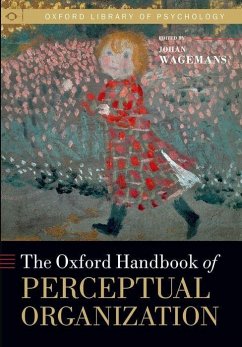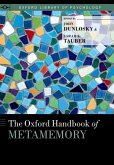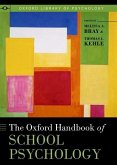- Gebundenes Buch
- Merkliste
- Auf die Merkliste
- Bewerten Bewerten
- Teilen
- Produkt teilen
- Produkterinnerung
- Produkterinnerung
Perceptual organization comprises a wide range of processes such as perceptual grouping, figure-ground organization, filling-in, completion, perceptual switching, etc. Such processes are most notable in the context of shape perception but they also play a role in texture perception, lightness perception, color perception, motion perception, depth perception, etc. Perceptual organization deals with a variety of perceptual phenomena of central interest, studied from many different perspectives, including psychophysics, experimental psychology, neuropsychology, neuroimaging, neurophysiology, and…mehr
Andere Kunden interessierten sich auch für
![The Oxford Handbook of Metamemory The Oxford Handbook of Metamemory]() The Oxford Handbook of Metamemory258,99 €
The Oxford Handbook of Metamemory258,99 €![Oxford Handbook of School Psychology Oxford Handbook of School Psychology]() Peter E NathanOxford Handbook of School Psychology257,99 €
Peter E NathanOxford Handbook of School Psychology257,99 €![Oxford Handbook of Suicide and Self-Injury Oxford Handbook of Suicide and Self-Injury]() Oxford Handbook of Suicide and Self-Injury271,99 €
Oxford Handbook of Suicide and Self-Injury271,99 €![Oxford Handbook of Exercise Psychology Oxford Handbook of Exercise Psychology]() Oxford Handbook of Exercise Psychology294,99 €
Oxford Handbook of Exercise Psychology294,99 €![The Oxford Handbook of Feminist Multicultural Counseling Psychology The Oxford Handbook of Feminist Multicultural Counseling Psychology]() The Oxford Handbook of Feminist Multicultural Counseling Psychology294,99 €
The Oxford Handbook of Feminist Multicultural Counseling Psychology294,99 €![The Oxford Handbook of Substance Use and Substance Use Disorders The Oxford Handbook of Substance Use and Substance Use Disorders]() The Oxford Handbook of Substance Use and Substance Use Disorders258,99 €
The Oxford Handbook of Substance Use and Substance Use Disorders258,99 €![Oxford Handbook of Deaf Studies, Language, and Education, Volume 1 Oxford Handbook of Deaf Studies, Language, and Education, Volume 1]() Marc MarscharkOxford Handbook of Deaf Studies, Language, and Education, Volume 1217,99 €
Marc MarscharkOxford Handbook of Deaf Studies, Language, and Education, Volume 1217,99 €-
-
-
Perceptual organization comprises a wide range of processes such as perceptual grouping, figure-ground organization, filling-in, completion, perceptual switching, etc. Such processes are most notable in the context of shape perception but they also play a role in texture perception, lightness perception, color perception, motion perception, depth perception, etc. Perceptual organization deals with a variety of perceptual phenomena of central interest, studied from
many different perspectives, including psychophysics, experimental psychology, neuropsychology, neuroimaging, neurophysiology, and computational modeling. Given its central importance in phenomenal experience, perceptual organization has also figured prominently in classic Gestalt writings on the
topic, touching upon deep philosophical issues regarding mind-brain relationships and consciousness. In addition, it attracts a great deal of interest from people working in applied areas like visual art, design, architecture, music, and so forth.
The Oxford Handbook of Perceptual Organization provides a broad and extensive review of the current literature, written in an accessible form for scholars and students. With chapter written by leading researchers in the field, this is the state-of-the-art reference work on this topic, and will be so for many years to come.
Hinweis: Dieser Artikel kann nur an eine deutsche Lieferadresse ausgeliefert werden.
many different perspectives, including psychophysics, experimental psychology, neuropsychology, neuroimaging, neurophysiology, and computational modeling. Given its central importance in phenomenal experience, perceptual organization has also figured prominently in classic Gestalt writings on the
topic, touching upon deep philosophical issues regarding mind-brain relationships and consciousness. In addition, it attracts a great deal of interest from people working in applied areas like visual art, design, architecture, music, and so forth.
The Oxford Handbook of Perceptual Organization provides a broad and extensive review of the current literature, written in an accessible form for scholars and students. With chapter written by leading researchers in the field, this is the state-of-the-art reference work on this topic, and will be so for many years to come.
Hinweis: Dieser Artikel kann nur an eine deutsche Lieferadresse ausgeliefert werden.
Produktdetails
- Produktdetails
- Oxford Library of Psychology
- Verlag: Oxford University Press
- Seitenzahl: 1118
- Erscheinungstermin: 13. Oktober 2015
- Englisch
- Abmessung: 254mm x 174mm x 53mm
- Gewicht: 1888g
- ISBN-13: 9780199686858
- ISBN-10: 0199686858
- Artikelnr.: 41882797
- Herstellerkennzeichnung
- Libri GmbH
- Europaallee 1
- 36244 Bad Hersfeld
- gpsr@libri.de
- Oxford Library of Psychology
- Verlag: Oxford University Press
- Seitenzahl: 1118
- Erscheinungstermin: 13. Oktober 2015
- Englisch
- Abmessung: 254mm x 174mm x 53mm
- Gewicht: 1888g
- ISBN-13: 9780199686858
- ISBN-10: 0199686858
- Artikelnr.: 41882797
- Herstellerkennzeichnung
- Libri GmbH
- Europaallee 1
- 36244 Bad Hersfeld
- gpsr@libri.de
Johan Wagemans has a BA in psychology and philosophy, an MSc and a PhD in experimental psychology, all from the University of Leuven, where he is currently a full professor. Current research interests are mainly in so-called mid-level vision (perceptual grouping, figure-ground organization, depth and shape perception) but stretching out to low-level vision (contrast detection and discrimination) and high-level vision (object recognition and categorization), including applications in autism, arts, and sports. He is supervising a long-term research program aimed at reintegrating Gestalt psychology into contemporary vision science and neuroscience (see www.gestaltrevision.be) He is chief-editor of Perception, i-Perception and Art & Perception.
* Section One: General Background
* 1: Johan Wagemans: Historical and conceptual background: Gestalt
theory
* 2: Liliana Albertazzi: Philosophical background: Phenomenology
* 3: Jan Koenderink: Methodological background: Experimental
phenomenology
* Section Two: Groups, Patterns, Textures
* 4: Joseph L. Brooks: Traditional and new principles of perceptual
grouping
* 5: James R. Pomerantz and Anna I. Cragin: Emergent features and
feature combination
* 6: Peter A. van der Helm: Symmetry perception
* 7: Ruth Kimchi: The perception of hierarchical structure
* 8: Statistical regularities
* 9: Ruth Rosenholtz: Texture perception
* Section Three: Contours and Shapes
* 10: Robert F. Hess, Keith A. May, and Serge O. Dumoulin: Contour
Integration: Psychophysical, neurophysiological, and computational
perspectives
* 11: James H. Elder: Bridging the dimensional gap: Perceptual
organization of contour in two-dimensional shape
* 12: Manish Singh: Visual representation of contour and shape
* Section Four: Figure-Ground Organization
* 13: Mary A. Peterson: Low-level and high-level contributions to
figure-ground organization
* 14: Marco Bertamini and Roberto Casati: Figures and holes
* 15: Rob van Lier and Walter Gerbino: Perceptual completions
* 16: Matthew W. Self and Pieter R. Roelfsema: The neural mechanisms of
figure-ground segregation
* 17: Naoki Kogo and Raymond van Ee: Neural mechanisms of figure-ground
organization: Border-ownership, competition and perceptual switching
* 18: Steven W. Zucker: Border inference and border ownership. The
challenge of integrating geometry and topology
* Section Five: Surface and Colour Perception
* 19: Alan Gilchrist: Perceptual organization in lightness
* 20: Walter Gerbino: Achromatic transparency
* 21: Hannah Smithson: Perceptual organization of colour
* 22: Barton L. Anderson: The perceptual representation of
transparency, lightness, and gloss
* Section Six: Motion and Event Perception
* 23: Michael Herzog and Haluk Ogmen: Apparent motion and reference
frames
* 24: Nicola Bruno and Marco Bertamini: Perceptual organization and the
aperture problem
* 25: Stefano Vezzani, Peter Kramer, and Paola Bressan: Stereokinetic
effect, kinetic depth effect,and structure from motion
* 26: Christopher D. Blair, Peter U. Tse, and Gideon P. Caplovitz:
Interactions of form and motion in the perception of moving objects
* 27: Howard S. Hock: Dynamic grouping motion: A method for determining
perceptual organization for objects with connected surfaces
* 28: Martin A. Giese: Biological and body motion perception
* Section Seven: Perceptual Organization and other Modalities
* 29: Susan L. Denham and Istvan Winkler: Auditory perceptual
organization
* 30: Astrid M. L. Kappers and Wouter M. Bergmann Tiest: Tactile and
haptic perceptual organization
* 31: Charles Spence: Cross-modal perceptual organization
* 32: Noelle R. B. Stiles and Shinsuke Shimojo: Sensory substitution: A
new perceptual experience
* 33: Melvyn A. Goodale and Tzvi Ganel: Different modes of visual
organization for perception and for action
* Section Eight: Special Interest Topics
* 34: Paul C. Quinn and Ramesh S. Bhatt: Development of perceptual
organization in infancy
* 35: Lee de-Wit and Johan Wagemans: Individual differences in local
and global perceptual organization
* 36: Celine R. Gillebert and Glyn W. Humphreys: Mutual interplay
between perceptual organization and attention: a neuropsychological
perspective
* 37: Marlene Behrmann, Jennifer J. Richler, Galia Avidan, and Ruth
Kimchi: Holistic face perception
* 38: David Alais and Randolph Blake: Binocular rivalry and perceptual
ambiguity
* 39: D. Samuel Schwarzkopf and Geraint Rees: Perceptual organization
and consciousness
* 40: Alex Holcombe: The temporal organization of perception
* Section Nine: Applications of Perceptual Organization
* 41: Daniel Osorio and Innes C. Cuthill: Camouflage and perceptual
organization in the animal kingdom
* 42: Gert J. van Tonder and Dhanraj Vishwanath: Design insights:
Gestalt, Bauhaus and Japanese gardens
* 43: Jan J. Koenderink: Perceptual organization in visual art
* Section Ten: Theoretical Approaches
* 44: Jungseock Joo, Shuo Wang, and So ng-Chun Zhu: Hierarchical
organization by and-or tree
* 45: Jacob Feldman: Probabilistic models of perceptual features
* 46: James T. Townsend and Michael J. Wenger: On the dynamic
perceptual characteristics of Gestalten: Theory-based methods
* 47: Cees van Leeuwen: Hierarchical stages or emergence in perceptual
integration?
* 48: Cees van Leeuwen: Cortical dynamics and oscillations: What
controls what we see?
* 49: Jacob Feldman: Bayesian models of perceptual organization
* 50: Peter A. van der Helm: Simplicity in perceptual organization
* 51: Jan J. Koenderink: Gestalts as ecological templates
* 1: Johan Wagemans: Historical and conceptual background: Gestalt
theory
* 2: Liliana Albertazzi: Philosophical background: Phenomenology
* 3: Jan Koenderink: Methodological background: Experimental
phenomenology
* Section Two: Groups, Patterns, Textures
* 4: Joseph L. Brooks: Traditional and new principles of perceptual
grouping
* 5: James R. Pomerantz and Anna I. Cragin: Emergent features and
feature combination
* 6: Peter A. van der Helm: Symmetry perception
* 7: Ruth Kimchi: The perception of hierarchical structure
* 8: Statistical regularities
* 9: Ruth Rosenholtz: Texture perception
* Section Three: Contours and Shapes
* 10: Robert F. Hess, Keith A. May, and Serge O. Dumoulin: Contour
Integration: Psychophysical, neurophysiological, and computational
perspectives
* 11: James H. Elder: Bridging the dimensional gap: Perceptual
organization of contour in two-dimensional shape
* 12: Manish Singh: Visual representation of contour and shape
* Section Four: Figure-Ground Organization
* 13: Mary A. Peterson: Low-level and high-level contributions to
figure-ground organization
* 14: Marco Bertamini and Roberto Casati: Figures and holes
* 15: Rob van Lier and Walter Gerbino: Perceptual completions
* 16: Matthew W. Self and Pieter R. Roelfsema: The neural mechanisms of
figure-ground segregation
* 17: Naoki Kogo and Raymond van Ee: Neural mechanisms of figure-ground
organization: Border-ownership, competition and perceptual switching
* 18: Steven W. Zucker: Border inference and border ownership. The
challenge of integrating geometry and topology
* Section Five: Surface and Colour Perception
* 19: Alan Gilchrist: Perceptual organization in lightness
* 20: Walter Gerbino: Achromatic transparency
* 21: Hannah Smithson: Perceptual organization of colour
* 22: Barton L. Anderson: The perceptual representation of
transparency, lightness, and gloss
* Section Six: Motion and Event Perception
* 23: Michael Herzog and Haluk Ogmen: Apparent motion and reference
frames
* 24: Nicola Bruno and Marco Bertamini: Perceptual organization and the
aperture problem
* 25: Stefano Vezzani, Peter Kramer, and Paola Bressan: Stereokinetic
effect, kinetic depth effect,and structure from motion
* 26: Christopher D. Blair, Peter U. Tse, and Gideon P. Caplovitz:
Interactions of form and motion in the perception of moving objects
* 27: Howard S. Hock: Dynamic grouping motion: A method for determining
perceptual organization for objects with connected surfaces
* 28: Martin A. Giese: Biological and body motion perception
* Section Seven: Perceptual Organization and other Modalities
* 29: Susan L. Denham and Istvan Winkler: Auditory perceptual
organization
* 30: Astrid M. L. Kappers and Wouter M. Bergmann Tiest: Tactile and
haptic perceptual organization
* 31: Charles Spence: Cross-modal perceptual organization
* 32: Noelle R. B. Stiles and Shinsuke Shimojo: Sensory substitution: A
new perceptual experience
* 33: Melvyn A. Goodale and Tzvi Ganel: Different modes of visual
organization for perception and for action
* Section Eight: Special Interest Topics
* 34: Paul C. Quinn and Ramesh S. Bhatt: Development of perceptual
organization in infancy
* 35: Lee de-Wit and Johan Wagemans: Individual differences in local
and global perceptual organization
* 36: Celine R. Gillebert and Glyn W. Humphreys: Mutual interplay
between perceptual organization and attention: a neuropsychological
perspective
* 37: Marlene Behrmann, Jennifer J. Richler, Galia Avidan, and Ruth
Kimchi: Holistic face perception
* 38: David Alais and Randolph Blake: Binocular rivalry and perceptual
ambiguity
* 39: D. Samuel Schwarzkopf and Geraint Rees: Perceptual organization
and consciousness
* 40: Alex Holcombe: The temporal organization of perception
* Section Nine: Applications of Perceptual Organization
* 41: Daniel Osorio and Innes C. Cuthill: Camouflage and perceptual
organization in the animal kingdom
* 42: Gert J. van Tonder and Dhanraj Vishwanath: Design insights:
Gestalt, Bauhaus and Japanese gardens
* 43: Jan J. Koenderink: Perceptual organization in visual art
* Section Ten: Theoretical Approaches
* 44: Jungseock Joo, Shuo Wang, and So ng-Chun Zhu: Hierarchical
organization by and-or tree
* 45: Jacob Feldman: Probabilistic models of perceptual features
* 46: James T. Townsend and Michael J. Wenger: On the dynamic
perceptual characteristics of Gestalten: Theory-based methods
* 47: Cees van Leeuwen: Hierarchical stages or emergence in perceptual
integration?
* 48: Cees van Leeuwen: Cortical dynamics and oscillations: What
controls what we see?
* 49: Jacob Feldman: Bayesian models of perceptual organization
* 50: Peter A. van der Helm: Simplicity in perceptual organization
* 51: Jan J. Koenderink: Gestalts as ecological templates
* Section One: General Background
* 1: Johan Wagemans: Historical and conceptual background: Gestalt
theory
* 2: Liliana Albertazzi: Philosophical background: Phenomenology
* 3: Jan Koenderink: Methodological background: Experimental
phenomenology
* Section Two: Groups, Patterns, Textures
* 4: Joseph L. Brooks: Traditional and new principles of perceptual
grouping
* 5: James R. Pomerantz and Anna I. Cragin: Emergent features and
feature combination
* 6: Peter A. van der Helm: Symmetry perception
* 7: Ruth Kimchi: The perception of hierarchical structure
* 8: Statistical regularities
* 9: Ruth Rosenholtz: Texture perception
* Section Three: Contours and Shapes
* 10: Robert F. Hess, Keith A. May, and Serge O. Dumoulin: Contour
Integration: Psychophysical, neurophysiological, and computational
perspectives
* 11: James H. Elder: Bridging the dimensional gap: Perceptual
organization of contour in two-dimensional shape
* 12: Manish Singh: Visual representation of contour and shape
* Section Four: Figure-Ground Organization
* 13: Mary A. Peterson: Low-level and high-level contributions to
figure-ground organization
* 14: Marco Bertamini and Roberto Casati: Figures and holes
* 15: Rob van Lier and Walter Gerbino: Perceptual completions
* 16: Matthew W. Self and Pieter R. Roelfsema: The neural mechanisms of
figure-ground segregation
* 17: Naoki Kogo and Raymond van Ee: Neural mechanisms of figure-ground
organization: Border-ownership, competition and perceptual switching
* 18: Steven W. Zucker: Border inference and border ownership. The
challenge of integrating geometry and topology
* Section Five: Surface and Colour Perception
* 19: Alan Gilchrist: Perceptual organization in lightness
* 20: Walter Gerbino: Achromatic transparency
* 21: Hannah Smithson: Perceptual organization of colour
* 22: Barton L. Anderson: The perceptual representation of
transparency, lightness, and gloss
* Section Six: Motion and Event Perception
* 23: Michael Herzog and Haluk Ogmen: Apparent motion and reference
frames
* 24: Nicola Bruno and Marco Bertamini: Perceptual organization and the
aperture problem
* 25: Stefano Vezzani, Peter Kramer, and Paola Bressan: Stereokinetic
effect, kinetic depth effect,and structure from motion
* 26: Christopher D. Blair, Peter U. Tse, and Gideon P. Caplovitz:
Interactions of form and motion in the perception of moving objects
* 27: Howard S. Hock: Dynamic grouping motion: A method for determining
perceptual organization for objects with connected surfaces
* 28: Martin A. Giese: Biological and body motion perception
* Section Seven: Perceptual Organization and other Modalities
* 29: Susan L. Denham and Istvan Winkler: Auditory perceptual
organization
* 30: Astrid M. L. Kappers and Wouter M. Bergmann Tiest: Tactile and
haptic perceptual organization
* 31: Charles Spence: Cross-modal perceptual organization
* 32: Noelle R. B. Stiles and Shinsuke Shimojo: Sensory substitution: A
new perceptual experience
* 33: Melvyn A. Goodale and Tzvi Ganel: Different modes of visual
organization for perception and for action
* Section Eight: Special Interest Topics
* 34: Paul C. Quinn and Ramesh S. Bhatt: Development of perceptual
organization in infancy
* 35: Lee de-Wit and Johan Wagemans: Individual differences in local
and global perceptual organization
* 36: Celine R. Gillebert and Glyn W. Humphreys: Mutual interplay
between perceptual organization and attention: a neuropsychological
perspective
* 37: Marlene Behrmann, Jennifer J. Richler, Galia Avidan, and Ruth
Kimchi: Holistic face perception
* 38: David Alais and Randolph Blake: Binocular rivalry and perceptual
ambiguity
* 39: D. Samuel Schwarzkopf and Geraint Rees: Perceptual organization
and consciousness
* 40: Alex Holcombe: The temporal organization of perception
* Section Nine: Applications of Perceptual Organization
* 41: Daniel Osorio and Innes C. Cuthill: Camouflage and perceptual
organization in the animal kingdom
* 42: Gert J. van Tonder and Dhanraj Vishwanath: Design insights:
Gestalt, Bauhaus and Japanese gardens
* 43: Jan J. Koenderink: Perceptual organization in visual art
* Section Ten: Theoretical Approaches
* 44: Jungseock Joo, Shuo Wang, and So ng-Chun Zhu: Hierarchical
organization by and-or tree
* 45: Jacob Feldman: Probabilistic models of perceptual features
* 46: James T. Townsend and Michael J. Wenger: On the dynamic
perceptual characteristics of Gestalten: Theory-based methods
* 47: Cees van Leeuwen: Hierarchical stages or emergence in perceptual
integration?
* 48: Cees van Leeuwen: Cortical dynamics and oscillations: What
controls what we see?
* 49: Jacob Feldman: Bayesian models of perceptual organization
* 50: Peter A. van der Helm: Simplicity in perceptual organization
* 51: Jan J. Koenderink: Gestalts as ecological templates
* 1: Johan Wagemans: Historical and conceptual background: Gestalt
theory
* 2: Liliana Albertazzi: Philosophical background: Phenomenology
* 3: Jan Koenderink: Methodological background: Experimental
phenomenology
* Section Two: Groups, Patterns, Textures
* 4: Joseph L. Brooks: Traditional and new principles of perceptual
grouping
* 5: James R. Pomerantz and Anna I. Cragin: Emergent features and
feature combination
* 6: Peter A. van der Helm: Symmetry perception
* 7: Ruth Kimchi: The perception of hierarchical structure
* 8: Statistical regularities
* 9: Ruth Rosenholtz: Texture perception
* Section Three: Contours and Shapes
* 10: Robert F. Hess, Keith A. May, and Serge O. Dumoulin: Contour
Integration: Psychophysical, neurophysiological, and computational
perspectives
* 11: James H. Elder: Bridging the dimensional gap: Perceptual
organization of contour in two-dimensional shape
* 12: Manish Singh: Visual representation of contour and shape
* Section Four: Figure-Ground Organization
* 13: Mary A. Peterson: Low-level and high-level contributions to
figure-ground organization
* 14: Marco Bertamini and Roberto Casati: Figures and holes
* 15: Rob van Lier and Walter Gerbino: Perceptual completions
* 16: Matthew W. Self and Pieter R. Roelfsema: The neural mechanisms of
figure-ground segregation
* 17: Naoki Kogo and Raymond van Ee: Neural mechanisms of figure-ground
organization: Border-ownership, competition and perceptual switching
* 18: Steven W. Zucker: Border inference and border ownership. The
challenge of integrating geometry and topology
* Section Five: Surface and Colour Perception
* 19: Alan Gilchrist: Perceptual organization in lightness
* 20: Walter Gerbino: Achromatic transparency
* 21: Hannah Smithson: Perceptual organization of colour
* 22: Barton L. Anderson: The perceptual representation of
transparency, lightness, and gloss
* Section Six: Motion and Event Perception
* 23: Michael Herzog and Haluk Ogmen: Apparent motion and reference
frames
* 24: Nicola Bruno and Marco Bertamini: Perceptual organization and the
aperture problem
* 25: Stefano Vezzani, Peter Kramer, and Paola Bressan: Stereokinetic
effect, kinetic depth effect,and structure from motion
* 26: Christopher D. Blair, Peter U. Tse, and Gideon P. Caplovitz:
Interactions of form and motion in the perception of moving objects
* 27: Howard S. Hock: Dynamic grouping motion: A method for determining
perceptual organization for objects with connected surfaces
* 28: Martin A. Giese: Biological and body motion perception
* Section Seven: Perceptual Organization and other Modalities
* 29: Susan L. Denham and Istvan Winkler: Auditory perceptual
organization
* 30: Astrid M. L. Kappers and Wouter M. Bergmann Tiest: Tactile and
haptic perceptual organization
* 31: Charles Spence: Cross-modal perceptual organization
* 32: Noelle R. B. Stiles and Shinsuke Shimojo: Sensory substitution: A
new perceptual experience
* 33: Melvyn A. Goodale and Tzvi Ganel: Different modes of visual
organization for perception and for action
* Section Eight: Special Interest Topics
* 34: Paul C. Quinn and Ramesh S. Bhatt: Development of perceptual
organization in infancy
* 35: Lee de-Wit and Johan Wagemans: Individual differences in local
and global perceptual organization
* 36: Celine R. Gillebert and Glyn W. Humphreys: Mutual interplay
between perceptual organization and attention: a neuropsychological
perspective
* 37: Marlene Behrmann, Jennifer J. Richler, Galia Avidan, and Ruth
Kimchi: Holistic face perception
* 38: David Alais and Randolph Blake: Binocular rivalry and perceptual
ambiguity
* 39: D. Samuel Schwarzkopf and Geraint Rees: Perceptual organization
and consciousness
* 40: Alex Holcombe: The temporal organization of perception
* Section Nine: Applications of Perceptual Organization
* 41: Daniel Osorio and Innes C. Cuthill: Camouflage and perceptual
organization in the animal kingdom
* 42: Gert J. van Tonder and Dhanraj Vishwanath: Design insights:
Gestalt, Bauhaus and Japanese gardens
* 43: Jan J. Koenderink: Perceptual organization in visual art
* Section Ten: Theoretical Approaches
* 44: Jungseock Joo, Shuo Wang, and So ng-Chun Zhu: Hierarchical
organization by and-or tree
* 45: Jacob Feldman: Probabilistic models of perceptual features
* 46: James T. Townsend and Michael J. Wenger: On the dynamic
perceptual characteristics of Gestalten: Theory-based methods
* 47: Cees van Leeuwen: Hierarchical stages or emergence in perceptual
integration?
* 48: Cees van Leeuwen: Cortical dynamics and oscillations: What
controls what we see?
* 49: Jacob Feldman: Bayesian models of perceptual organization
* 50: Peter A. van der Helm: Simplicity in perceptual organization
* 51: Jan J. Koenderink: Gestalts as ecological templates








